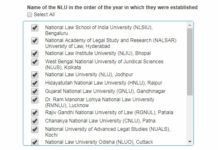Padmini Baruah, the CLAT 2011 topper, writes a different kind of piece altogether which transcends the mundane of evanescent worries.
Shakti – the eternal, primordial force – has always been and will always be an integral part of our religion and mythology. Interestingly, in a society where the man has always been accorded far greater importance than the woman, Shakti has always been personified as female. Sati, the consort of Shiva, entered into a terrible fit of rage at her father when he refused to invite his son-in-law to a yagna that he had organised. Woman’s anger – always awe-inspiring even as it is self destructive – manifested itself within her and made her undertake the ultimate of all sacrifices: self immolation. Needless to say, Shiva’s fury was stoked. He, in his grief, lifted the body and embarked on a march that, in its intensity, threatened to destroy the world. At this stage, Vishnu, the eternal Preserver, followed him and artfully sliced off Sati’s body little by little. And thus, when Sati’s body was no more, did Shiva calm down.
The basic reason why I talk about religion today is to relive the experience of Kamakhya. Kamakhya is supposed to be one of the most famous of the Shakti Peeths, where Sati’s womb is supposed to have fallen. Built atop the Neelachal Hills in Guwahati, this temple has innumerable legends attached to it (allow me to explore these in some later article). Nonetheless, this note is not going to be a travelogue or a religious discourse. I only wish to talk about what the temple is supposed to stand for, and where it actually is today.
Kamakhya is, at the basic level, meant to be a tribute to the eternal strength and fertility of woman. It is not a site where one can come and beg and plead before the Goddess. It is a place where one has to sense the power that lies latent within the Goddess; to experience awe at the unlimited capacity of the Goddess to foster creation as well as unleash destruction over the Universe. All who have visited Kamakhya will have noticed that the architecture of the place is stone-based, dark, and somewhat suffocating. The idea is to allow the Goddess to engulf you the moment you enter the shrine. There are no wide, open spaces: the mind must not wander here and there; only the Goddess can be your sole Mistress. As you plunge into the darkness to touch the sacred water, you can only focus your mind on the force of Shakti.
But, as I specified above, that is the idea behind Kamakhya. The reality of course, like all realities of ritual, is far removed. Kamakhya today is commercialization of religion, through and through. Right from the shopkeepers who accost you with deals of coconuts and incense to the red-garbed Pandas (to be very fair, our personal Panda was quite an upright man) to the people who keep shoving you – Kamakhya at the moment leaves no room for Divinity. A queue of epic proportions builds up at the gates of the temple even before the light of dawn has broken. After four hours of getting crammed through ghetto-ic waiting spaces (complete with prison bars), you are made to pass in an assembly line with the Pandas shouting “Aagot Jaok!” (in Assamese, it translates to – “Move Ahead!”) in your ears. The moment you try to summon Divinity, the person behind you gives you a push. Unceremoniously, you are thrown out of the shrine before you can even begin to appreciate the enormous significance of Kamakhya.
I agree that given the crowds, there is a need to rush the proceedings. However, doesn’t the Tourism Department/Kamakhya Board even feel the need for comprehensive renovation? A little more space, better waiting rooms, and a little more ambience (yes, ambience: maybe have mantras chanting on loudspeakers) would do wonders for the mood of all the pilgrims who are so keen to pay their tribute to Sati.
I am not one for ritual and superstition myself. Prayer is prayer, anywhere you choose to do it, and if you can be at peace without prayer, that is fine too. However, considering that so many people from all over the country come searching for a moment of divinity, a moment when they can bend their knees and express awe at the Immortal Might – when will Kamakhya truly recover its lost essence? That, seekers, is what remains to be seen.
Padmini Baruah.















I can completely get your drift. Summoning divinity, or even paying your respects to the higher power is so commercialised, that the point of it is lost. It’s so hard to even manage to stand in those crowds with someone constantly shoving you, forget trying to steal a moment to absorb that radiance, that divine grace. The state of affairs of any temple or shrine today is dismal, because there’s always a struggle or a fight for a blessing, when in truth, there doesn’t even have to be. If there should be one in the name of God, it is not a blessing. A prayer is a prayer, wherever performed, but when in a shrine, it is truly a different experience altogether. It is sad that the Kamakhya Board has failed to realise the importance of it. But it’s more or less the same everywhere, the commercialisation I mean.
After reading this, I really want to visit Assam. Great article. You put it so amazingly well. 🙂 Can’t wait for your next one about the temple.
You know, to properly capture divinity…I’ve realised that what you need is pure, concentrated SILENCE.
No temple has that on offer, sadly. Do come to Assam, see it for yourself.
true….
not only in Assam… depart to any corner of the world… u’ll see a rush… divine shrines are being transformed into “come-have-a-glimpse-go” centers…. u can’t evn rejoice the beauty…indulge into the divine environment…. I’v visited tirupati…shabari mala shrine….which are known for their divinity and spiritual essence … but as we enter it we can’t evn wait their for a moment…there’s the same echo “move ahead” maybe translated into a different lingo …but expresssing their detest for the stationary of the body trying to indulge into the spiritual essence of the soul ….
ya..a…this can b attributed to the inept handling by the authorities…. I also feel the same as you do..”the need of little ambience ” .. 🙂
*there for a moment
powerful writing!!!
What a narration. Rich. Coherent. Vivid.
i completely agree with you padmini…that there is a lost sense in the minds of people…..i find in the pilgrims no respect left for the divine….they rush to the holiest place on the earth just to let god know that they have arrived there just to have let their sins washed away…..poor beings they know not….that every action they do has a reaction secretly and carefully conspired by the universe….and it would leave no person without being affected by their action whether good or bad….!
well…i really wish for the sanctity to get restored in such wonderful places which makes man get immersed into the divinity……i want the same divine aura to be spread around such holy places for they are so rare to be felt!
wish that the assam tourism board would take some steps in order to make surroundings more easier to be experienced….!!
Divinity actually lies within, don’t you think? I wish we all could just find it!
thats very true…..but isnt it so that wind or breeze when flows makes us realise the presence of god!
the temples are such kind of places where the positive vibrations spreads around!……but ofcourse the god dwells in our heart!….no matter where you are the god is with us…i say this for he dwells right in our temple!
reading this brought back vivid recollection about my visit to the temple, i recollect being enthralled by sense of gravity which brought about a sense of calmness . luckily for us when i visited the temple for relatively empty, which allowed us to spend a lot more time. …… the serenity and beauty makes me want to visit the place more often 🙂
Lucky you, then.
We went on a Sunday…the line was endless, relentless. three different lines (yes, %00/-. 100/-, 50/- : Different prices for different levels of access. Weird huh.)
I wish I too could have found it.
This is something I hated about Kamakshya. Even the way to God can be shortened depending on the cash in your pockets. What irony! Kalyug Kalyug!
You have that down South as well. You name it, and they’ll have “Quick Darshanam: Rs. 40, and “Special Darshanam: Rs. 100. Commercialization is not a problem, it has become a disease.
The above is, er, well, a private joke. Pls disregard.
Padmini, I genuinely loved your piece of writing. You in fact remind me of a brilliantly-written Khushwant Singh article on the same Kamakhya temple. Religion is a powerful force, of course you have decoded for us what many would term and see as incomprehensive.
Kudos! Keep it up!
That really is humbling now.
Glad you liked it.
I am so overwhelmed.
Thank you so much for publishing it.
Divinity is strangely and intensely a personal affair. But after all the commercialisation of religion that you see in India – well, I felt strongly about it.
Thanks. Am humbled.
When all else fails God prevails.
Even the biggest atheist turns superstitious at times like these.
Absolutely..i agree completely with ur view
@clatgyan: why was my comment deleted? did you find it too offensive?
It was pending the last time I checked, I was deliberating whether we should allow it through or not.
Your comment, in itself wasn’t very offensive, but it’d have sparked off a debate that’d take us away from the topic, that’d be unjust to the writer’s work.
We can however, allow a post on The Window (if it meets the criteria) on the topic on which you’d written (Religion? God? What good has it ever done?)
hmm..i should have known.
but isnt debating the need of discussing an issue, a part of discussing that issue?
Not if it doesn’t pertain to the topic itself.
Understand one thing: I am not one for rituals and temples. In fact, I’m a breed of rational-spiritual.
So yeah, I understand your logic of “What good has it ever done?” I was like that myself.
But the power of belief is sometimes unbelievable. Maybe it’s a manifestation of faith in one’s own self. No idea. But I’d like a debate on it. If CLAT gyan permits!
The temple, is a nice place to go to, but for during festive times. though I speak of sometime in 2002-03. The ‘levels of access’ system wasn’t there then. They seem to find amazing ways to make money !
The part given below, is relevant only if CG permits the debate that Padmini talks of.
Rituals, and temples, or any other form of worship for that matter, may be a manifestation of one’s faith in oneself. But rarely so. So many people- I refrain from saying most- follow these simply because they have no faith in themselves, or in those whom they call their gods. These beliefs are mere impositions thrust upon them, from times immemorial, by the higher, more learned echelons of the society, the scholarly class that is, to ensure indirectly, the people’s subservience to themselves(the scholars). And people follow them to salvage some ‘punya’, needless to say, without righteous action. So much so, that we not only bribe the very gods we revere, but do so with preconditions.
Mother Kamaksha, will have to wait a while. We are in no mood to snap out of our stupor yet.
Bribe the Gods. Exactly. You’ve hit the nail on the head. Trace every single civilisation, Greek, Roman, Egyptian.
You’ll find that corruption sets in when you try to emphasize too much on ritual.
So it is.
And thus I wonder, what is it that keeps the Amazonian tribes and their African brethren going, despite rituals being supreme in all aspects of their lives.
Perhaps the fact that they commune directly with Mother Nature?
Rather than rely on the middlemen – priests etc.
Perhaps yes. The priest, if any, is by will of the clan, and merely represents the collective will of them all. Fits in perfectly with our line of argument.
Congrats Padmini on securing the 1st rank in CLAT…..Wish u a very bright future ahead….
Thanks so much!!!!
Justice V.R. Krishan Iyer is a Living Legend at 97. Legal Education is not complete without his contribution and human interpretation. He is a crusador of lost causes. he is the biggest champion of access to Justice. His Report on Legal Aid first for the Kerala Government & then for the Government of India reflect his concern for the ” We the People of India”. University must have a Chair on his name and his judgements should be made compulsory readings for the University. Dr Vinod Sethi
awesome!!
@CG… why don’t you ask her to write another article… something for us aspirants…. 🙂
i had been to kamakhya in assam,been to tirupathi but according to the words of the youth icon vivekanda u cant get peace or freedom UNLESS U detach YOUR the soul FROM VAIN TEMPTATION . its not bout the temple bout the environment. May be that’s the reason why most of the temples are in hilly regions. the hilly regions are really calm and far from the manning crowds. the places are pollution less and are almost incredible. the pious sound of the river flowing or the light breeze is a wonderful fabrication by the creator. makali the mahasakti is the creator. She exists in different places of our country and in different form/names . Her presence is symbol of divinity,integrity and impartiality. but sad enough that this areas are circled by pandas and some materialized persons. hatred for the kaluyug kaal for creating so many ashurs /demons, for polluting this divine lands. but we still have the power as our soul is jst like the concept of atoms. IT CAN NEITHER BE CREATED NOR BE DESTROYED. SO DETACH yourself to gain peace. AWESOME PIECE PADMINI!!!! SO TRUE AND HATS OFF 🙂
First of all,Padmini,it was a great article.very well written and it shows how much you feel about the issue of Kamakhya Shrine.well,to be frank this is the case everywhere.I remember going to Vaishnodevi wherein i faced a similar situation.the condition is same everywhere.The shrine boards are more concerned about money making and they hardly seem to bother what facilities are being provided and with what difficulties are the pilgrims going through.No proper dormitories,unhygienic environment,that eventually hinders tourism(even non-pilgrim sites) in India. I appreciate your effort to bring this to light.
Brilliant piece!!! Divinity is something which is very personal and commercialization in the name of religion and rituals is seriously sad!! Temples no longer remain a sacred place where one can experience spirituality,rather it has evolved over the years to become hubs of business activities!! Business corporations to say the least!!! SAD!!! 🙁